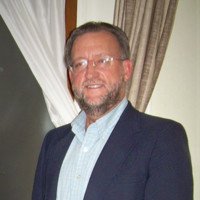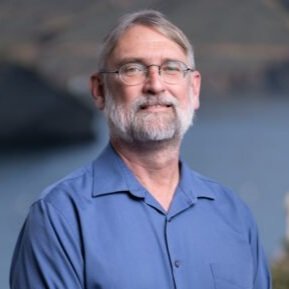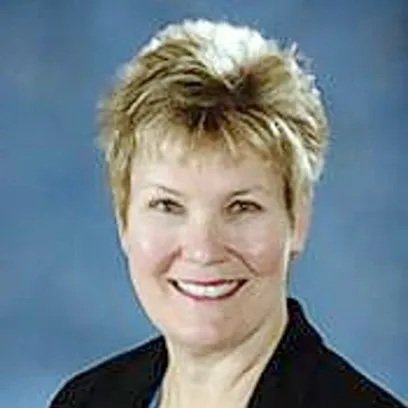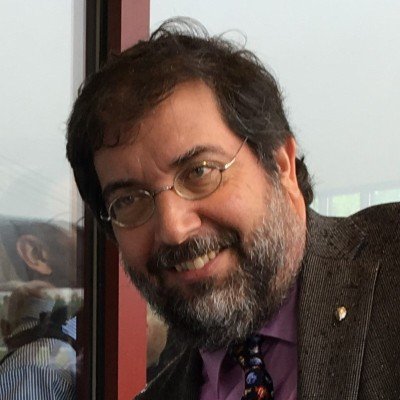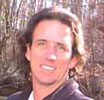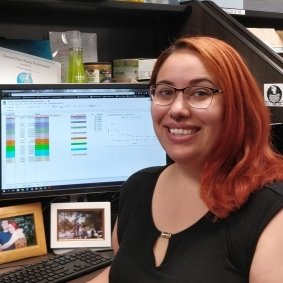Dr. Thomas S. Bianchi (PhD '87) is the James R. Whatley Chair in Geosciences and Professor in the Department of Oceanography at Texas A & M University. Dr. Bianchi's research interests are organic geochemistry, biogeochemical dynamics of aquatic food chains, carbon cycling in estuarine and coastal ecosystems, and biochemical markers of colloidal and particulate organic carbon. Currently, he conducts his research in the Gulf of Mexico estuaries, the Mississippi River, as well as his collaborative efforts in the Baltic Region. Following his MEES doctoral degree, he has held a number of research and academic positions, has numerous publications, and received two Fulbright Research Scholarships. Dr. Bianchi has been elected a 2013 AAAS Fellow. Click here for more information on Thomas and his research.
Dr. Jay Blundon (MS '81) graduated from the MEES program with a master's in 1981 under Dr. Vic Kennedy. Jay then received a Ph.D. from the Department of Zoology at the University of Maryland College Park, earning his degree in 1986 with a focus in neuroscience. He continued his neuroscience research as a postdoc at the University of Texas in Austin for 7 years. In 1993, Jay became an assistant professor of biology at Rhodes College in Memphis, TN. He became associate professor at Rhodes in 1999. Jay and his wife Lettie still live in Memphis, where Jay was the former Chair of the Neuroscience Program at Rhodes College. They have two sons: Brandon and Gaven. Dr. Blundon is an electrophysiologist currently serving as a Senior Scientist with Dr. Stanislav S. Zakharenko, Director of Neural Circuits and Behavior at St. Jude’s Research Hospital. For more information, please click here.
Dr. Jason Caplan (MS '82; PhD '84) is the founder and CEO of EnSolve Biosystems Inc., a biotechnology company based in the Research Triangle area of North Carolina. In business since 1995, the company has won numerous awards and financial support from the North Carolina Biotechnology Center for research and development. In addition to the PetroLiminator shipboard oily water separator system, EnSolve also markets bioenzymatic degreasers and oil-spill cleanup products for the marine industry. In December 2005, EnSolve Biosystems was awarded a Small Business Innovative Research contract by the U.S. Navy to develop a prototype Portable Oil Remediation System (PORS) for removal of hydrocarbons, organic contaminants, and trace metals normally found on inactive vessels. Dr. Caplan is a “serial” entrepreneur who has successfully started, operated and exited several biotechnology companies. He is an experienced CEO with a demonstrated history of developing and commercializing “green” remediation technologies for maritime and terrestrial applications. Dr. Caplan is now President & CEO of Sound Oaks Ventures, a consulting organization geared to help sustain and grow small to mid-size biotech companies, serves as an Adjunct Professor of Plant and Microbiology at North Carolina State University, and is the best selling author of Belhaven Blue, his first novel.
Dr. Jane Caffrey (PhD ’89) did her dissertation on “The effect of submerged macrophytes on nitrogen cycling in Fourleague Bay, Louisiana” working with Dr. W. Michael Kemp. After a varied career in government and universities, Jane is now an Associate Professor in the Center for Environmental Diagnostics and Bioremediation at the University of West Florida. Her research interests are estuarine nutrient biogeochemistry; in-situ nutrient analysis; and water quality, including the factors controlling dissolved oxygen dynamics and metabolism. Jane has been funded by EPA and EPRI to measure atmospheric deposition of mercury and trace metals to the Pensacola Bay watershed. She also works on Pensacola Bay water quality issues with local and state agencies. Check out her website here for more information on her work.
Dr. Michael Crosby (PhD '87) has been very busy since receiving his doctoral degree under Dr. Roger Newall! Now, he has over 25 years of research, teaching, science management and leadership experience and has gained expertise in developing and managing multidisciplinary research through his interactions, involvement and partnerships with numerous universities, national and international science and resource management agencies, programs and committees. His endeavors focus on improving the "synthesis, translation and transfer" of science and technical information between research, public policy and stakeholder communities. In July 2003, Dr. Crosby was appointed to the Senior Executive Service position at the National Science Foundation to serve as both executive officer and office director of the National Science Board (NSB). He came to NSB from the National Oceanic and Atmospheric Administration (NOAA), where he was the senior advisor for international science policy in the undersecretary's office of international affairs. His previous positions in NOAA include executive director for the NOAA science advisory board, national research coordinator for ocean and coastal resource management, and chief scientist for sanctuaries and reserves. He also completed a special detail from NOAA at the U.S. Agency for International Development, where he served for two years as the senior science advisor for marine and coastal ecosystems. Prior to joining NOAA, Dr. Crosby held numerous faculty positions at various institutions, including the Baruch Institute for Marine Biology and Coastal Research at the University of South Carolina; the department of marine science at Coastal Carolina University; the graduate program at the University of Charleston; Salisbury State University; and in science positions with the National Marine Fisheries Service, the U.S. Army Corps of Engineers, and the National Cancer Institute, National Institutes of Health. Crosby earned a doctorate in marine-estuarine-environmental sciences while studying under Dr. Rodger Newell at Horn Point Laboratory. He has received research grants from many agencies including NSF, NOAA, EPA, DOD and USAID. Dr. Crosby led major national and international, multidiscipline, multi-year research projects like the U.S. Man and the Biosphere Program project entitled "Ecological and Socio-Economic Impacts of Alternative Access Management Strategies in Marine and Coastal Protected Areas", and the U.S.-Israeli and Jordanian joint partnership project entitled "The Red Sea Marine Peace Park Cooperative Research, Monitoring and Management Program." He is also a member of the Natural Areas Association, the Coastal Society, the National Shellfisheries Association, the Estuarine Research Federation, Sigma Xi, The Scientific Research Society, The Pacific Congress on Marine Science and Technology, and the American Association for the Advancement of Science, as well as a fellow of the Royal Linnean Society of London. Crosby serves as a reviewer and panelist for numerous scientific journals and for national and international science panels and advisory committees. He has published over 40 articles in such publications as Marine Ecology Progress Series, Journal of Shellfish Research, Journal of Experimental Marine Biology and Ecology, Diseases of Aquatic Organisms, Marine Biology, Limnology and Oceanography, Ocean and Coastal Management, Natural Areas Journal, Coral Reefs, Oceanography, Aquatic Conservation, and various Technical Memoranda Series, and has edited several books and manuals dealing with marine protected areas and coral reefs. In May 2010, Dr. Crosby was appointed as Senior Vice President of Mote Marine Laboratory, following appointments As Associate Vice President for Research and Economic Development at George Mason University and Vice Chancellor for Research at the University of Hawaii-Hilo. In May 2013, he became President and CEO of the Mote Marine Laboratory and Aquarium. More information on the Mote Marine Lab can be found here.
Penelope Dalton (MS '87) was a teacher on a U.S. Navy base in Rota, Spain, and a Peace Corps volunteer in Kenya prior to joining the University of Maryland, MEES Program. After acceptance, Penelope pursued her graduate research and received the 1985 Knauss Marine Policy Fellowship. In 1987, Ms. Dalton completed her MEES master's thesis under the supervision of Dr. Mihursky at CBL. From 1987 to 1999, she was a professional staff member for the U.S. Senate Committee on Commerce, Science and Transportation. Ms. Dalton played a pivotal role in shaping marine policy at the national level. Reaching the senior level on the committee, she spoke before Congress and federal ocean agencies on behalf of 83 of the nation's largest oceanographic institutions. Dalton spent two years (1999-2001) at NOAA's National Marine Fisheries Service as assistant administrator, managing the 2,500-member scientific and technical staff in more than two-dozen facilities across the nation. She strengthened her career in 2001 by joining the Consortium for Oceanographic Research and Education, or CORE, in Washington, DC, as Vice President. In that position, Dalton helped give its members, which includes the University of Washington (UW) and other major oceanographic institutions, a unified voice on national and international ocean issues. In 2005, Penelope joined the University of Washington as Director of the Washington Sea Grant Program. With 20 years of experience in marine and coastal issues, she now leads an organization that funds research on such things as the accidental capture of endangered seabirds, introductions of harmful non-native animals and plants, shellfish farming techniques and new cancer-fighting medicines from the sea. Part of a network of 30 state programs administered by the National Oceanic and Atmospheric Administration (NOAA), Washington Sea Grant Program is one of the oldest and, with a budget of $5 million a year from federal and other funding sources, is the second largest behind California. At the UW, Washington Sea Grant is a part of the College of Ocean and Fishery Sciences. Dalton says her initial goal is to better serve Sea Grant's constituents by strengthening existing partnerships with the UW, other academic institutions, federal, state and local government, tribes, and marine-related industries and associations. After serving as Director of the Washington Sea Grant for over a decade, Dr. Dalton retired in May 2018 having mentored dozens of Knauss fellows, in addition to managing four additional fellowship programs at theWashington Sea Grant, including three she helped create. The University of Washington News sat down with Dalton during her final week for an interview, which you can find here.
Dr. Carol B. Daniels (PhD '87) is the National Parks Services (NPS) Coordinator for the Southern Florida and Caribbean Cooperative Ecosystems Studies Unit (SFC-CESU). This CESU was established in 2000 and has 6 federal agency partners and numerous university and private sector partners. The University of Miami's Rosensteil School of Marine and Atmospheric Sciences serves as the host and encompasses the southern end of Florida, Puerto Rico and Caribbean islands. For more information on the SFC CESU, click here.
Dr. John Dolan (MEES, Ph.D. '88) is a Senior Scientist at the Observatoire Oceanologique de Villefranche - a field campus of the Universite de Paris VI which houses 3 research-teaching units, co-administered by the Centre National de Recherche Scientifique (CNRS) and the Universite de Paris VI: Geology, Developmental Biology, and Oceanography. The oceanography laboratory, Laboratoire de Oceanographie de Villefranche (LOV) is composed of 5 research groups or departments. John is the head of the Marine Microbial Ecology Group. His specialty is ciliate microzooplankton, the first link in aquatic food chains and he began by working on problems of ciliate ontongeny and systematics with G. A. Antipa (San Francisco State University) and turned to ecosystem ecology with D.W. Coats (Smithsonian Institution) and E. B. Small (University of Maryland). Since matriculation from the MEES Program, John has studied natural populations of ciliate microzooplankton in the Chesapeake Bay, across the Mediterreanean Sea, and both the SW and SE Pacific Ocean. A particular interest of his is physiology (for example growth and feeding) in typical marine ciliates, freshwater nanoflagellates, as well as mixotrophic ciliates and nanoflagellates. He currently is examining diel patterns, digestion, and selective feeding in micro and nano zooplankton. For more information, or to contact John, click here.
Dr. Dan Jacobs (ENVSC, PhD'85) has been associated with Maryland Sea Grant for more than 20 years - first as a trainee and 1982 Knauss Fellow while a student in the MEES Program completing his doctoral degree under Dr. Robert Ulanowicz, followed by employment as the Information Systems Manager and Webmaster. Dr. Jacobs was instrumental in the development of the Maryland, and many other, Sea Grant program websites. All 30 programs and the National Sea Grant Office now have a solid web presence through the Sea Grant network. Jacobs holds a bachelor's degree in Wildlife Management from Rutgers University, a master's degree in Wildlife Management, with a minor in Statistics, from Frostburg University.
Dr. Stephen J. Jordan (MEES, Ph.D. '87) is currently the Assistant Laboratory Director of the National Health and Environmental Effects Research Laboratory with the U.S. EPA. Dr. Jordan was previously a Research Ecologist and Special Assistant to the Director with the U.S. EPA's Gulf Ecology Division (GED) in Gulf Breeze, Florida. Steve enjoys his employment because it allows him to work for a better environment while advancing the protection, restoration, and scientific understanding of aquatic ecosystems. He has extensive experience with in-service training in leadership, supervision, equal employment opportunities, procurement, staff development, personnel management, team building, organizational change. Many of these skills were just simply polished while being the Chief of the Ecosystem Assessment Branch, USEPA, Gulf Ecology Division. Prior to his appointment as Chief, Steve was the Director of the Sarbanes Cooperative Oxford Laboratory, Maryland Department of Natural Resources where he led the Laboratory from a period of physical decay, staff attrition and poor morale to a complete renovation and expansion of the physical plant, addition of new research programs and modern equipment, and an atmosphere of cooperation and optimism. Prior to that, he was the Director of the Oxford Laboratory Division of the Maryland Fisheries Service, and Chief of the Habitat Impacts Program, Maryland Department of Natural Resources for eight years where he led the development of new state-funded environmental programs, including Chesapeake Bay Living Resources Monitoring, Targeted Watershed Restoration, Chesapeake Bay Ambient Toxicity by developing program justifications, work plans, successful budget initiatives, recruited staff and did much of the initial technical work. Steve was also an associate faculty member for Johns Hopkins University School of Continuing Studies for the eight years prior to moving to Florida, where he helped develop and taught graduate Estuarine Ecology, Ecology of the Coastal Zone, The Chesapeake Bay: Ecology and Ecosystem Management, and Principles and Methods of Ecology. He has authored or co-authored of more than 30 peer-reviewed journal articles, book chapters, and published reports while authoring or co-authoring more than 40 presentations and posters at scientific meetings. Steve's success is recognized with the following accolades: Congressional Citation, Senator Paul S. Sarbanes, Congressional Record, 2002.; Governor’s Citation, Parris N. Glendenning, Governor, State of Maryland; Salute to Excellence, awarded by Maryland Governor Schaefer for the Chesapeake Executive Council, 1992; Chesapeake Bay Program Certificate of Appreciation for "outstanding and dedicated leadership. More information on the GED can be found here.
Dr. Adam Marsh (PhD '88) is an Associate Professor of Marine Biosciences in the University of Delaware's College of Earth, Ocean, and Environment. Dr. Marsh is researching the effects of cold temperatures on regulation of gene expression in embryos and larvae in deep-sea and polar ocean invertebrates in Antarctica and the Artic. Adam's primary research interests are the roles that molecular and biochemical mechanisms determine in growth and metabolism during early development in larvae from extreme environments (i.e., gene expression, RNA processing and turnover; protein metabolism and turnover; cellular physiology and energetics; organismal development and growth). Recently his work has demonstrated that despite the slow course of development, metabolic activities in some polar embryos and larvae are temperature compensated, and equivalent to comparable rates in temperate species. He is trying to identify the biochemical mechanism by which low temperatures set developmental rates in these polar species. Learn more about Adam by clicking here.
Dr. Frank E. Muller-Karger (PhD '88) is a biological oceanographer and a Professor at the College of Marine Science, University of South Florida, where he serves as Director of the Institute for Marine Remote Sensing. As some of you already know, he is of Hispanic descent via Puerto Rico, and while born in the U.S. he grew up in Venezuela. Frank conducts research on marine primary production using satellite remote sensing, large data sets, networking, and high-speed computing. His research helps in the location and monitoring of large-scale phenomena, understanding climate control and climate change, and in the interpretation of numerical models of the ocean. Presently, the primary focus of his research is to assess the importance of continental margins, including areas of upwelling, river discharge, and coral reefs in the global carbon budget, using satellites that measure ocean color and sea surface temperature. Dr. Muller-Karger has worked hard to educate K-12 teachers in the Southern Florida region about the use of new technologies in oceanography through targeted workshops sponsored by NASA. Frank has given lectures at various national educator societies, and serves as the science advisor for the Florida Center for Ocean Science Education Excellence (COSEE). He also led the effort to establish an internal committee within the College of Marine Science to define the college's mission with respect to education and outreach. Dr. Muller-Karger was appointed by President George W. Bush to serve on the U.S. Commission on Ocean Policy. In 2005, he was appointed to the Ocean Studies Board of the National Research Council/National Academies. Because of his keen interest in linking science and education processes, and his interest in addressing the problem of underserved and under-represented groups in academic science programs, he has been a champion for minorities, for educators, and science education within the Commission on Ocean Policy. Dr. Muller-Karger previously received the NASA Jet Propulsion Laboratory Award for Outstanding Contributions and the NASA Administrator Award for Exceptional Contribution and Service for supporting development of satellite technologies for ocean observation. He has B.S., M.S. and Ph.D. degrees in marine science and a Master's degree in management and has authored or co-authored over 80 scientific publications. Frank also speaks fluent Spanish and German. Learn more about Frank by clicking here.
Dr. Timothy Mulligan (PhD '87) is Professor Emeritus in the Fisheries Biology Department at Humboldt State University in Arcata, California, and was named Humboldt State University's Outstanding Professor of 2004-05. This is the university's highest honor for dedication and excellence in teaching. Mulligan has taught at HSU since 1989, and his students laud him for his energy, enthusiasm, personal attention, and grasp of detail. His faculty colleagues agree, noting that Mulligan personifies the university's long-standing commitment to practical learning through research, combined with rigorous classroom instruction. "Tim's most effective classroom - and, I suspect, his favorite classroom - is in the field," comments Dave Hankin, chair of HSU's Department of Fisheries Biology. "Depending on the class and the time of year, Tim's students may be working a beach seine [fishing net] in Trinidad Harbor or the Mad River estuary, pulling a small trawl through eel grass beds in Humboldt Bay, deploying small plankton nets in Stone Lagoon, or towing a bottom trawl off the [university research vessel] Coral Sea, several miles off shore from Eureka." Growing up 30 miles north of Boston and 30 minutes from the ocean, Mulligan spent a summer doing research on the Isle of Shoals that adjoins the Maine/New Hampshire coast while pursuing undergraduate studies at the University of Vermont . The experience fed a growing interest in various species of fish that cemented his fascination. He continued his education with graduate studies at the University of Central Florida and earned his doctorate from the University of Maryland MEES Program, studying striped bass in the Chesapeake Bay under Dr. Edward Houde. A postdoctoral fellowship took him west to the Bering Sea and the Gulf of Alaska to focus on walleye pollock, before he moved to HSU. "I've had to teach myself about Southern California fishes, just to keep up with my students," Mulligan says. "The really, really top students keep you on your toes. But most professors actually get more satisfaction from reaching the students who aren't as well prepared. If you can get them turned on, now that's something!"
Fred Pinkney (PhD '88) just celebrated his 20th year as Senior Biologist with the Environmental Contaminants Program, U.S. Fish and Wildlife Service, Chesapeake Bay Field Office in Annapolis, Maryland. He investigates a wide range of environmental contaminant issues including skin and liver tumors in brown bullhead catfish in the Chesapeake Bay watershed, endocrine disruption in smallmouth and largemouth bass, reproductive problems in yellow perch, the occurrence of abnormal frogs on National Wildlife Refuges, and bioaccumulation of PCBs in fish from the Potomac and Anacostia Rivers. He is active in committees and workgroups related to the cleanup of the Anacostia River and toxic chemical issues in the Chesapeake Bay. He frequently collaborates with scientists from the U.S. Geological Survey, Maryland Department of Natural Resources, and District Department of the Environment and has served on graduate student committees at several universities. He lives in Takoma Park, Maryland where he enjoys gardening, tennis, playing piano, and softball. A recent highlight was pitching the final innings for the Fish and Wildlife Service’s 2013 Tournament Championship Team in the Maryland DNR league at Sandy Point State Park. Here is the team photo. His older son and team shortstop, Gabe, was born while Fred was working on his dissertation at CBL.


